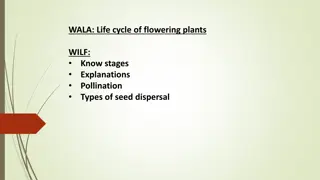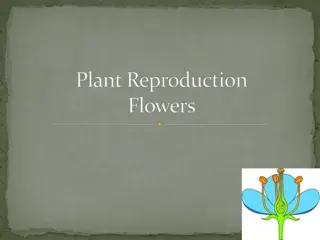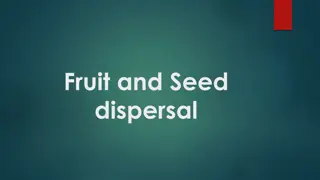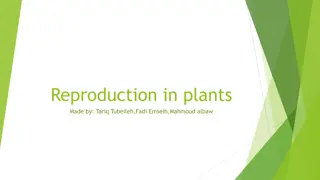Understanding Pollination: Types and Factors
Pollination is the crucial process of transferring pollen for fertilization and seed production in plants. It can be self-pollination or cross-pollination, with different types of dehiscence affecting how pollen is released. Self-pollination occurs in hermaphroditic and monoecious plants, with factors like bisexuality and cleistogamy influencing the process. Viola flowers can exhibit both chasmogamous and cleistogamous characteristics. Self-pollination offers advantages in maintaining genetic stability and conserving parental traits.
Download Presentation

Please find below an Image/Link to download the presentation.
The content on the website is provided AS IS for your information and personal use only. It may not be sold, licensed, or shared on other websites without obtaining consent from the author. Download presentation by click this link. If you encounter any issues during the download, it is possible that the publisher has removed the file from their server.
E N D
Presentation Transcript
Pollination Pollination is the transfer of pollen from a male part of a plant to a female part of a plant, later enabling fertilization and the production of seeds. It is of two types: 1. Self Pollination or autogamy 2. Cross Pollination or Allogamy : there are two types A Xenogamy Different Plants B Geitonogamy Same plant
Types of Dehiscence Transverse dehiscence: In this, pollen releases away from the centre of the unilocular anther. Example: Members of the Malvaceae family. Longitudinal dehiscence: Here, the pollen releases laterally or longitudinally, neither towards nor away from the axis. Example: Datura Poricidal dehiscence: In this type, pollen releases from the apical or distal region. Example: Potato, Brinjal etc. Valvular dehiscence: In this type, the anther wall opens like trap doors from where the pollen releases. Example: Berberries, Laurus etc.
Which Flowers self pollinate Both hermaphrodite and monoecious species have the potential for self- pollination leading to self-fertilization unless there is a mechanism to avoid it. Eighty percent of all flowering plants are hermaphroditic, meaning they contain both sexes in the same flower, while 5 percent of plant species are monoecious. The remaining 15% would therefore be dioecious (each plant unisexual). Plants that self-pollinate include several types of orchids, and sunflowers. Dandelions are also capable of self-pollination as well as cross-pollination
Factors affecting self pollination Bisexuality Homogamy Cleistogamy seen in peanuts, peas and Viola Bud Pollination in peas and grass family
Viola flower can be both chasmogamous and cleistogamous
Advantages of Self Pollination There are several advantages for self-pollination. Firstly, if a given genotype is well-suited for an environment, self-pollination helps to keep this trait stable in the species. Not being dependent on pollinating agents allows self-pollination to occur when bees and wind are nowhere to be found. Self-pollination can be an advantage when the number of flowers is small or they are widely spaced. During self-pollination, the pollen grains are not transmitted from one flower to another. As a result, there is less wastage of pollen, They also cannot make changes in their characters and so the features of a species can be maintained with purity. Self-pollination also helps to preserve parental characters as the gametes from the same flower are evolved. It is not necessary for flowers to produce nectar, scent, or to be colourful in order to attract pollen.
Disadvantages of self-pollination The disadvantages of self-pollination come from a lack of variation that allows no adaptation to the changing environment or potential pathogen attack. Self-pollination can lead to inbreeding depression caused by expression of deleterious recessive mutations or to the reduced health of the species, due to the breeding of related specimens. This is why many flowers that could potentially self-pollinate have a built-in mechanism to avoid it, or make it second choice at best. Genetic defects in self-pollinating plants cannot be eliminated by genetic recombination and offspring can only avoid inheriting the deleterious attributes through a chance mutation arising in a gamete.
Commelina benghalensis shows both cleistogamous and Chasmogamous flowers
Floral Mechanisms favouring Cross Pollination Self Sterility or self incompatibility eg Petunia axillaris Dichogamy: Protandry eg Saxifraga and Impatiens Protogyny eg Aristolochia Herkogamy eg Caryophyllaceous flowers Heterostyly Distyly in Primula vulgaris (pin and thrum eyed flowers) Tristyly in Lythrum and Oxallis
Herkogamy: In bisexual flowers the essential organs, the stamens and stigmas, are arranged in such a way that self-pollination becomes impossible. For example in Gloriosa superba, the style is reflexed away from the stamens and in Hibiscus the stigmas project far above the stamens
Advantages of Cross Pollination Offsprings produced are healthier New varieties can be produced through cross-pollination of two varieties of the same species or two species Seeds that are produced are abundant and viable
Disadvantages of Cross Pollination It is not always certain as a pollinating agent is always required, and it may or may not be available at the suitable time. Pollen grains have to be produced in abundance to ensure chances of pollination.
Pollen Storage Dry and Cold Storage Cryogenic Storage Organic Sovents
Pollen Viability tests Seed set or ovule development after pollination Pollen germination and pollen tube growth In vitro pollen germination Tetrazolium chloride test Fluorescein diacetate test NMR method
References https://owlcation.com/stem/6-Agents-of-Pollination https://www.youtube.com/watch?v=SqjPJQvsYy8























